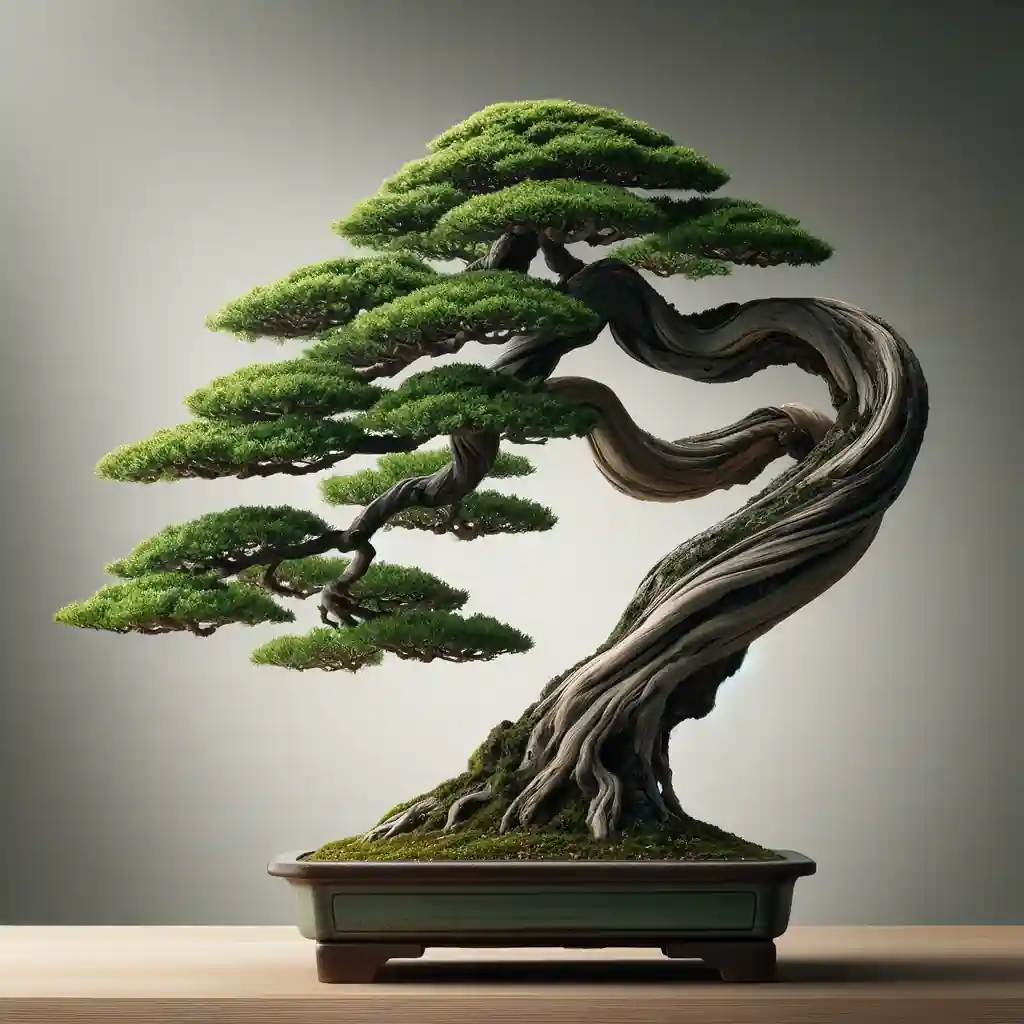Introduction to Bonsai
Definition and Origins of Bonsai
Bonsai, which translates to “planted in a container,” is an ancient Japanese art form that involves cultivating miniature trees in pots or containers. Its origins can be traced back to China over a thousand years ago, where it was known as “penzai.”
The Art and Philosophy Behind Bonsai
Bonsai is an art form deeply rooted in philosophy. It embodies concepts like harmony, balance, and simplicity. The careful shaping of trees and the use of negative space reflect the beauty of nature in a confined space.
Why Bonsai Enthusiasts Are Captivated
Bonsai enthusiasts are captivated by the unique combination of creativity, patience, and horticultural skills that the art demands. The sense of connection with nature and the satisfaction of watching a tiny tree thrive are profoundly rewarding.
Types of Bonsai

Outdoor Bonsai
Outdoor bonsai trees can be further categorized into:
Deciduous Trees
Deciduous bonsai trees, like the Japanese Maple, showcase the changing seasons through their leaves. Their natural beauty is celebrated as they transition through spring, summer, autumn, and winter.
Coniferous Trees
Coniferous bonsai trees, such as Pine and Juniper, maintain their green foliage year-round. They are known for their rugged and picturesque appearance, symbolizing resilience.
Broadleaf Evergreens
Broadleaf evergreen bonsai, like the Ficus and Boxwood, retain their leaves throughout the year. They offer a consistent and vibrant presence in the bonsai world.
Indoor Bonsai
Indoor bonsai trees thrive in controlled environments and are suitable for those with limited outdoor space or harsh climates. They include:
Tropical Bonsai
Tropical bonsai trees, such as the Ficus Ginseng and Schefflera, originate from warm and humid regions. They adapt well to indoor conditions and offer unique foliage and forms.
Subtropical Bonsai
Subtropical bonsai trees, like the Dwarf Jade and Fukien Tea, are hardy and can tolerate indoor conditions with proper care. They provide a blend of elegance and durability.
Bonsai Styles
Bonsai styles reflect the artistic expression of the grower and the tree’s natural characteristics. Some common styles include:
Formal Upright
“Chokkan” in Japanese. Straight, tapering trunk, symmetrical branches symbolize strength and dignity. Demands meticulous care, favored by bonsai enthusiasts for its balanced, elegant appearance.
Informal Upright
Informal upright bonsai, known as “Moyogi” in Japanese, feature slightly curved or meandering trunks, mirroring the organic shapes of trees in the wild. They evoke a sense of natural grace and beauty, capturing the essence of untamed nature in a miniature form.
Broom style
“Hokidachi” bonsai feature a straight, upright trunk with branches forming a symmetrical, broom-like shape. They exude simplicity and elegance, embodying a refined aesthetic.
Slanting
“Shakan” bonsai showcase a striking slanted trunk, infusing dynamic energy and captivation. This style introduces movement and allure to bonsai compositions, making them truly engaging.
Semi-Cascade
“Han-Kengai” bonsai showcase trunks that gracefully cascade without touching the ground, imparting a dramatic, dynamic aesthetic, evoking a vivid sense of movement and fascination.
Cascade
“Kengai” bonsai feature trunks cascading below the pot’s rim, resembling trees near cliffs or waterfalls. They embody resilience and capture captivating natural beauty.
Windswept
“Fukinagashi” bonsai showcase branches and foliage swept to one side, mimicking the effects of strong winds. They symbolize endurance and adaptability, capturing nature’s resilience.
Literati
“Bunjin” bonsai exhibit distinctive, contorted forms and irregular growth, conveying artistic freedom and individuality. They celebrate uniqueness and offer a creative expression of nature’s beauty.
Forest
“Yose-ue” bonsai entails planting multiple trees together, mimicking a miniature forest. It mirrors the diversity and interconnectedness found in nature, creating a harmonious composition.
In the next sections of this guide, we’ll delve deeper into getting started with bonsai, selecting the right tree, essential tools, and caring for your miniature masterpiece.
Getting Started with Bonsai
Choosing the Right Bonsai Tree
Selecting the ideal bonsai tree is a crucial first step on your journey. Consider factors like:
- Experience Level: Beginners may find it easier to start with hardy species like the Ficus or Juniper.
- Climate: Match your tree’s hardiness to your local climate for outdoor bonsai.
- Style: Choose a tree that appeals to your preferred bonsai style, whether formal upright, cascade, or others.
Essential Bonsai Tools and Supplies
To properly care for your bonsai and help it thrive, you’ll want to have a set of essential tools and supplies readily available. These items will play a crucial role in maintaining the health, shape, and aesthetics of your miniature masterpiece. Below, we’ll delve into each of these essentials, providing a comprehensive guide for bonsai enthusiasts:
- Pruning Shears: Pruning shears are indispensable for precision trimming of branches and foliage. These specialized bonsai scissors allow you to make clean, controlled cuts, promoting healthy growth and shaping your tree as desired. Consider investing in high-quality pruning shears like these Wazakura Yasugi Trimming Scissors for optimal results.
- Training Wire: Training wire is a must-have for shaping and training your bonsai branches. It allows you to gently guide the growth of your tree, creating the desired structure and style. Choose different gauges of training wire based on the thickness of the branches you’re working with. For a reliable training wire set, check out this Anodized Aluminum Bonsai Training Wire Set from Grow A Bonsai.
- Soil Mix: The right soil mix is essential for your bonsai’s well-being. Different tree species require specific soil compositions for optimal growth. Invest in a well-draining soil mix tailored to your particular bonsai type. I would suggest doing research before buying soil.
- Pots and Containers: Selecting the right pots or containers is not only about aesthetics but also about the health of your bonsai. The pot should complement your tree’s style and provide adequate drainage. Consider options like this 12 pack of 6.5 inch training pots that will allow you to start your bonsai collection without breaking the bank.
- Watering Can: Proper watering is crucial for bonsai care. A watering can with a fine nozzle allows you to control the flow of water, preventing soil erosion and ensuring even distribution.
- Bonsai Turntable: Simplify your bonsai maintenance routine with a bonsai turntable. This handy tool allows you to rotate your tree effortlessly, ensuring that every side receives adequate sunlight and even growth. Look for a durable and smooth-turning turntable like the Aketek 12 Inch Heavy Duty Rotating Swivel.
Creating Your Bonsai
- Repotting: Understand the importance of repotting and follow a schedule based on your tree’s age and growth.
- Pruning and Shaping: Learn techniques for branch and foliage pruning, as well as wiring for shape and position.
- Styles and Aesthetics: Discover how to create different bonsai styles, from formal upright to cascade and more.
In the following sections, we’ll explore the care and maintenance of your bonsai, including soil and repotting, watering and feeding, and ensuring proper sunlight and temperature conditions.
Bonsai Care and Maintenance
Taking proper care of your bonsai is essential to ensure its health, beauty, and longevity. In this section, we’ll dive into the specifics of bonsai care and maintenance to help you nurture your miniature masterpiece.
Soil and Repotting
Soil Composition: Bonsai trees require a well-draining soil mix to prevent root rot and encourage healthy root development. Depending on the type of bonsai, you may need a mix that includes components like Akadama, pumice, and lava rock. Understanding your specific tree’s soil needs is crucial.
Repotting Schedule: Repotting is a critical aspect of bonsai care. It allows you to refresh the soil, trim the roots, and provide your tree with essential nutrients. The frequency of repotting depends on factors such as the tree’s age, species, and growth rate. Younger bonsai may need repotting every one to two years, while older trees may require it less often.
Step-by-Step Repotting Guide: Repotting can seem daunting, but a step-by-step guide simplifies the process. It includes selecting the right time to repot, carefully removing the tree from its pot, trimming the roots, and transplanting it into fresh soil. Proper repotting ensures your bonsai continues to thrive and grow vigorously.
Watering and Feeding
Proper Watering Techniques: Watering is a skill that every bonsai enthusiast must master. The goal is to keep the soil consistently moist but not soggy. Factors like temperature, humidity, and the size of the pot influence how often you should water. Frequent, light watering during the growing season and reduced watering in the winter are common practices.
Fertilizing Bonsai: Bonsai trees require essential nutrients for healthy growth and vibrant foliage. Fertilize your bonsai during the growing season, typically from spring to early autumn. Choose a balanced, liquid fertilizer or specialized bonsai fertilizer, and follow the recommended application rates. Remember that over-fertilization can harm your tree, so use fertilizer judiciously.
Seasonal Considerations: Bonsai care varies throughout the year. During spring and summer, when growth is active, your tree may require more water and nutrients. In contrast, fall and winter call for reduced watering and protection from harsh weather conditions. Pay attention to your tree’s specific needs based on the season and adjust your care routine accordingly.
Sunlight and Temperature
Understanding Light Requirements: Bonsai trees have varying light requirements based on their species. Some thrive in full sun, while others prefer partial shade. Research your tree’s specific needs and place it in an appropriate location. Consider using grow lights for indoor bonsai to ensure they receive adequate light.
Winter Care for Outdoor and Indoor Bonsai: Winter demands special attention to protect your bonsai. Outdoor bonsai should be sheltered from frost and freezing temperatures. Indoor bonsai benefit from proper lighting and humidity maintenance. Consider using a humidity tray or humidifier to provide moisture during the dry winter months.
Incorporating these care practices into your routine will help your bonsai flourish. Remember that each tree is unique, so monitor its condition closely and adjust your care regimen accordingly. With patience and dedication, you’ll enjoy the beauty of your miniature masterpiece for years to come.
Bonsai Display and Aesthetics
Displaying your bonsai effectively is an art in itself. This section covers the aesthetics and techniques of showcasing your miniature trees.
Bonsai Pots and Containers
Choosing the right pot or container is crucial for enhancing the overall aesthetic appeal of your bonsai. Factors to consider include size, style, color, and material. The pot should complement your tree’s form and create harmony.
Bonsai Stands and Displays
Elevate your bonsai’s presentation with suitable stands or display arrangements. Wooden stands, stone slabs, or even ornamental alcoves can provide an elegant backdrop for your bonsai. Experiment with different displays to find what suits your tree best.
Choosing the Right Display Location
Placement matters when it comes to bonsai. Outdoor bonsai should be positioned to receive the correct amount of sunlight for their species. Indoor bonsai require well-lit areas away from drafts and temperature extremes. Proper placement enhances the tree’s health and aesthetic impact.
Seasonal Display Considerations
Change your bonsai’s display as the seasons shift. In spring, showcase vibrant flowering bonsai. In autumn, emphasize trees with colorful foliage. Winter can highlight the tree’s elegant structure. Rotating your display keeps your bonsai visually appealing year-round.
Troubleshooting and Common Issues
Even the most seasoned bonsai enthusiasts encounter challenges. This section addresses common issues and provides solutions to help keep your bonsai thriving.
Pests and Diseases
Identifying and addressing pests and diseases promptly is crucial. Common pests include aphids, scale insects, and spider mites. Fungal infections and root rot can also occur. Learn to recognize the signs of infestations or diseases and apply appropriate treatments, including organic solutions and pesticides when necessary.
Yellowing Leaves and Dropping Foliage
Yellowing leaves or dropping foliage can indicate various issues, such as overwatering, underwatering, or nutrient deficiencies. We’ll explore how to diagnose the specific cause and take corrective action to restore your bonsai’s health.
Root Rot
Root rot is a serious concern, especially when soil drainage is inadequate. Discover how to prevent root rot and how to treat it if it occurs, including repotting with well-draining soil and trimming affected roots.
Overwatering and Underwatering
Both overwatering and underwatering can harm your bonsai. Understand the signs of each condition and learn the correct watering practices to maintain the right moisture balance for your tree.
In the upcoming sections, we’ll delve into advanced techniques for experienced bonsai enthusiasts and valuable resources to further enrich your bonsai journey.
Advanced Techniques and Styling
For seasoned bonsai enthusiasts seeking to elevate their skills and artistic expression, this section delves into advanced techniques and styling options that allow you to take your bonsai to new heights.
Air Layering
The Art of Propagation: Air layering is a fascinating propagation technique that allows you to create new bonsai trees or enhance existing ones. By encouraging root development in a specific area of the tree’s trunk or branches, you can later separate it to become a distinct bonsai. Mastering air layering opens up endless possibilities for shaping and expanding your bonsai collection.
Step-by-Step Process:
- Select a Healthy Branch: Choose a branch on your bonsai tree that you want to propagate or improve.
- Make a Diagonal Cut: Create an upward diagonal cut through the branch, about 1-2 inches from the trunk.
- Apply Rooting Hormone: Dust the exposed cut with rooting hormone powder to stimulate root growth.
- Wrap with Damp Moss: Wrap the cut section with damp sphagnum moss, covering it completely.
- Seal with Plastic: Securely wrap plastic around the moss and branch to create a sealed environment.
- Monitor and Water: Keep the moss consistently damp, misting as needed to maintain humidity.
- Wait for Roots: Over several weeks to months, roots will develop within the moss.
- Remove and Transplant: Once a strong root system forms, cut below the air layer and transplant it into a bonsai pot with well-draining soil.
Yamadori (Collecting Wild Bonsai)
Exploring the Wild: Yamadori, the art of collecting wild trees and transforming them into bonsai, is a thrilling endeavor for experienced enthusiasts. Discover the ethics and techniques behind responsibly collecting trees from natural environments. Learn how to adapt these found treasures into captivating bonsai specimens while preserving their unique character.
Creating Bonsai Forests (Yose-ue)
Emulating Nature’s Diversity: Bonsai forests, known as Yose-ue, aim to replicate the diversity of a forest ecosystem within a single container. Explore the techniques involved in selecting and arranging multiple bonsai trees to create harmonious and captivating miniature forests.
Bonsai Exhibition and Competition
Showcasing Your Skills: Participating in bonsai exhibitions and competitions is a valuable way to showcase your expertise and gain recognition within the community. Understand the intricate process of preparing your bonsai for display, adhering to exhibition rules, and effectively presenting your artistry to judges and enthusiasts.
Presentation and Judging: Learn the art of presentation, including selecting the right accent elements, stands, and display materials to complement your bonsai’s aesthetics. Discover how judges evaluate bonsai in competitions and gain insights into the criteria they use for assessment.
In the following sections, we’ll provide you with valuable resources for furthering your bonsai journey and conclude your exploration of the captivating world of miniature trees.
Resources for Bonsai Enthusiasts
To further enrich your bonsai journey and expand your knowledge, this section provides valuable resources and references for bonsai enthusiasts.
Books and Publications
- “The Bonsai Bible” by Peter Chan: A comprehensive guide covering all aspects of bonsai care, styling, and techniques.
- “The Complete Book of Bonsai: A Practical Guide to Its Art and Cultivation” by Harry Tomlinson: An excellent beginner’s book with practical advice.
- Bonsai Magazines: Explore publications like “Bonsai Today” and “International Bonsai” for in-depth articles, inspiration, and expert insights.
Online Communities and Forums
- BonsaiNut: A popular online forum where bonsai enthusiasts from around the world discuss topics, share experiences, and seek advice.
- Bonsai Empire: An informative website with articles, tutorials, and an active forum community.
- Reddit Bonsai: The Bonsai subreddit offers a platform for discussions, sharing photos, and seeking advice from fellow enthusiasts.
Clubs and Workshops
- Local Bonsai Clubs: Join a local bonsai club or society to connect with other enthusiasts, attend workshops, and learn from experienced members.
- Bonsai Workshops: Many experienced bonsai artists and professionals offer workshops and classes to help you hone your skills.
Nurseries and Suppliers
- Local Nurseries: Visit local bonsai nurseries to find trees, tools, and supplies. Nurseries often provide valuable insights and guidance.
- Online Suppliers: Explore online retailers specializing in bonsai materials, from soil and pots to tools and wire.
Exhibitions and Shows
- Bonsai Exhibitions: Attend bonsai exhibitions and shows in your region to admire exquisite bonsai displays and learn from master artists.
- Bonsai Shows: Participate in local bonsai shows to showcase your own creations and receive feedback from judges and fellow enthusiasts.
By utilizing these resources, you can continually expand your bonsai knowledge, connect with like-minded individuals, and refine your skills as a bonsai enthusiast. Whether you’re a beginner or an experienced practitioner, the world of bonsai offers endless opportunities for growth and creativity.
Cultivating Beauty in Miniature
In this comprehensive guide, we’ve explored the art of bonsai, from its origins and styles to advanced techniques and valuable resources. Whether you’re a beginner starting your bonsai journey or an experienced enthusiast seeking to refine your skills, the world of bonsai offers endless opportunities for growth and creativity.
By applying the principles of bonsai care, aesthetics, and styling, you can cultivate miniature masterpieces that reflect nature’s beauty and your artistic vision. Remember to connect with fellow enthusiasts, explore valuable resources, and continue your bonsai journey with passion and dedication.
May your bonsai endeavors bring you joy, serenity, and a deeper appreciation for the artistry of nature in miniature.







